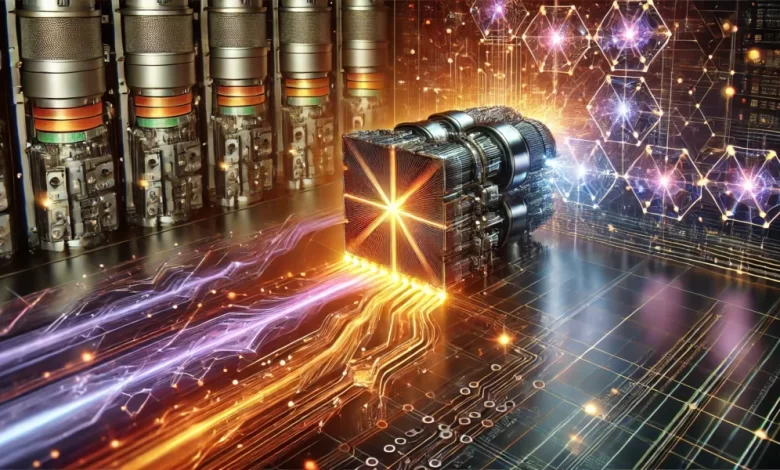A Game-Changer for AI: The Tsetlin Machine’s Role in Reducing Energy Consumption

The rapid rise of artificial intelligence (AI) has transformed countless industries, from healthcare and finance to energy management and beyond. However, this growth in AI adoption has resulted in a significant energy consumption problem. Modern AI models, especially those based on deep learning and neural networks, are incredibly energy hungry. Training a single large-scale model can consume as much energy as several households consume annually, leading to significant environmental impacts. As AI becomes more and more embedded in our daily lives, finding ways to reduce its energy consumption is not just a technical challenge; it is an environmental priority.
The Tsetlin machine offers a promising solution. Unlike traditional neural networks, which rely on complex mathematical calculations and massive data sets, Tsetlin Machines take a simpler, rules-based approach. This unique methodology makes them easier to interpret and significantly reduces energy consumption.
Understanding the Tsetlin Machine
The Tsetlin Machine is an AI model that reimagines learning and decision-making. Unlike neural networks, which rely on layers of neurons and complex computations, Tsetlin Machines use a rule-based approach powered by simple Boolean logic. We can think of Tsetlin machines as machines that learn by creating rules to represent data patterns. They work using binary operations, conjunctions, disjunctions and negations, making them inherently simpler and less computationally intensive than traditional models.
TMs work on the principle of reinforcement learning, using Tsetlin Automata to adjust their internal states based on feedback from the environment. These automatons function as state machines that learn to make decisions by flipping bits. As the machine processes more data, it refines its decision-making rules to improve accuracy.
A key feature that distinguishes Tsetlin machines from neural networks is that they are easier to understand. Neural networks often work as “black boxes”, deliver results without explaining how they got there. Tsetlin machines, on the other hand, create clear, human-readable rules as they learn. This transparency makes Tsetlin Machines more user-friendly and simplifies the process of repairing and improving them.
Recent developments have made Tsetlin Machines even more efficient. One essential improvement is deterministic state leapsmeaning the machine no longer relies on generating random numbers to make decisions. In the past, Tsetlin Machines used random changes to adjust their internal states, which was only sometimes efficient. By switching to a more predictable, step-by-step approach, Tsetlin Machines now learn faster, respond faster and use less energy.
The current energy challenge in AI
The rapid growth of AI has led to a massive increase in energy consumption. The main reason is the training and deployment of deep learning models. These models, which power systems such as image recognition, language processing and recommendation systems, require enormous amounts of data and complex mathematical operations. For example, training a language model like GPT-4 involves processing billions of parameters and can take days or weeks on powerful, power-hungry hardware like GPUs.
A study of the University of Massachusetts Amherst shows the significant impact of AI’s high energy consumption. Researchers found that training a single AI model can emit more than 626,000 pounds of CO₂, about the same as the emissions of five cars over their lifetime. This large carbon footprint is due to the extensive computing power required, often using GPUs for days or weeks at a time. Furthermore, the data centers where these AI models are hosted consume a lot of electricity, mostly from non-renewable energy. As the use of AI becomes more widespread, the environmental costs of using these power-hungry models are becoming a major concern. This situation highlights the need for more energy-efficient AI models, such as the Tsetlin Machine, which aims to balance strong performance with sustainability.
There is also the financial side to consider. High energy consumption means higher costs, making AI solutions less affordable, especially for smaller companies. This situation shows why we urgently need more energy-efficient AI models that deliver strong performance without harming the environment. This is where the Tsetlin machine is a promising alternative.
The energy efficiency and comparative analysis of Tsetlin machine
The most notable advantage of Tsetlin Machines is their energy efficiency. Traditional AI models, especially deep learning architectures, require extensive matrix calculations and floating point operations. These processes are computationally intensive and result in high energy consumption. Tsetlin machines, on the other hand, use lightweight binary operations, which significantly reduces their computational burden.
To quantify this difference, let’s look at the work of Literal laboratoriesa business manager of Tsetlin Machines applications. Literal Labs has discovered that Tsetlin Machines may include the following capabilities 10,000 times more energy efficient then neural networks. For tasks such as image recognition or text classification, Tsetlin machines can match the accuracy of traditional models while consuming only a fraction of the power. This makes them especially useful for low-power environments, such as IoT devices, where saving every watt of power is critical.
Additionally, Tsetlin machines are designed to run efficiently on standard, low-power hardware. Unlike neural networks that often require specialized hardware such as GPUs or TPUs for optimal performance, Tsetlin machines can function effectively on CPUs. This reduces the need for expensive infrastructure and minimizes the overall energy footprint of AI operations. Recent benchmarks support this advantage, showing that Tsetlin machines can perform a variety of tasks, from anomaly detection to language processing, with much less computing power than their neural network counterparts.
If you compare Tsetlin machines with neural networks, you will see a clear difference in energy consumption. Neural networks require significant energy during both training and inference. They often require specialized hardware, which increases both environmental and financial costs. However, Tsetlin machines use simple rule-based learning and binary logic, resulting in much lower computational requirements. This simplicity allows Tsetlin Machines to scale well in energy-constrained environments such as edge computing or IoT.
While neural networks may outperform Tsetlin Machines on some complex tasks, Tsetlin Machines excel where energy efficiency and interpretability matter most. However, they do have limitations. For example, Tsetlin Machines can struggle with extremely large data sets or complex problems. To address this, research continues into hybrid models that combine the strengths of Tsetlin Machines with other AI techniques. This approach could help overcome current challenges and broaden their use cases.
Applications in the energy sector
Tsetlin machines have had a significant impact on the energy sector, where efficiency is of paramount importance. Below are some critical applications:
Smart networks and energy management
Modern smart grids use real-time data to optimize energy distribution and predict demand. Tsetlin Machines analyzes consumption patterns, detects deviations and predicts future energy needs. For example in the The British national electricity gridTsetlin Machines helps with predictive maintenance by identifying potential failures before they occur, preventing costly breakdowns and reducing energy waste.
Predictive maintenance
In industries where machines are critical, unexpected breakdowns can waste energy and cause downtime. Tsetlin Machines analyzes sensor data to predict when maintenance is required. This proactive approach ensures machines operate efficiently, reducing unnecessary power consumption and extending equipment life.
Renewable energy management
Managing renewable energy sources such as solar and wind energy requires a balance between production, storage and distribution. Tsetlin Machines predicts energy generation based on weather patterns and optimizes storage systems to efficiently meet demand. Accurate predictions from Tsetlin Machines help create a more stable and sustainable energy network, reducing dependence on fossil fuels.
Recent developments and innovations
The domain of Tsetlin Machine research is dynamic, with continuous innovations to improve performance and efficiency. Recent developments include the creation of multi-step finite state automata, allowing Tsetlin Machines to perform more complex tasks with improved accuracy. These advancements expand the range of problems that Tsetlin Machines can tackle, making them applicable to scenarios previously dominated by neural networks.
Furthermore, researchers have introduced methods to reduce the reliance on random number generation within Tsetlin Machines, opting for deterministic state changes instead. This shift speeds up learning, reduces computing requirements and, most importantly, reduces energy consumption. As researchers refine these mechanisms, Tsetlin machines are becoming increasingly competitive with more traditional AI models, especially in domains where low energy consumption is a priority.
The bottom line
The Tsetlin machine is more than just a new AI model. It represents a shift towards sustainability in technology. The focus on simplicity and energy efficiency challenges the idea that powerful AI must come at a high environmental cost.
In addition to ongoing AI developments, Tsetlin Machines offer a path forward where advanced technology and environmental responsibility go hand in hand. This approach is a technical breakthrough and a step towards a future where AI serves humanity and the planet. In conclusion, embracing Tsetlin Machines can be essential to building a more innovative, greener world.






